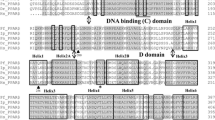Abstract
Peroxisome proliferators-activated receptors (PPARs) plays important role in regulate a variety of target genes which involves in lipid metabolism. In the present study, 1,430 bp of PPARα and 1,650 bp of PPARγ in Peking duck (Anas platyrhynchos) were cloned by reverse transcription (RT)-PCR. The cloned sequences of PPARα and PPARγ were highly conserved, although relevant changes with respect to human, mouse, chicken, and goose were identified. Real-time quantitative RT-PCR was used to determine if the PPARα and PPARγ were expressed in different tissues of male and female Peking ducks. The expression of PPARα and PPARγ were widely distributed in all examined tissues. The expression level of PPARα was highest in liver and lowest in kidney in male and female ducks. And it was highest in abdominal fat and lowest in small intestine of PPARγ in male and female ducks.



Similar content being viewed by others
References
Schoonjans K, Staels B, Auwerx J (1996) The peroxisome proliferator-activated receptors (PPARs) and their effects on lipid metabolism and adipocyte differentiation. Biochim Biophys Acta 1302:93–109
Issemann I, Green S (1990) Activation of a member of the steroid hormone receptor superfamily by peroxisome proliferators. Nature 347:645–650. doi:10.1038/347645a0
Dreyer C, Krey G, Keller F et al (1992) Control of the peroxisomal beta-oxidation pathway by a novel family of nuclear hormone receptors. Cell 68:879–887. doi:10.1016/0092-8674(92)90031-7
Wahli W, Braissant O, Desvergne B (1995) Peroxisome proliferator-activated receptors: transcriptional regulators of adipogenesis, lipid metabolism and more. Chem Biol 2:261–266. doi:10.1016/1074-5521(95)90045-4
Dreyer C, Keller H, Mahfoudi A et al (1993) Positive regulation of the peroxisomal beta-oxydation pathway by fatty acids through activation of peroxisome proliferators-activated receptors (PPAR). Biol Cell 77:67–76. doi:10.1016/S0248-4900(05)80176-5
Tontonoz P, Hu E, Spiegelman BM (1994) Stimulation of adipogenesis in fibroblasts by PPAR-γ2, a lipid-activated transcription factor. Cell 79:1147–1156. doi:10.1016/0092-8674(94)90006-X
Lehmann JM, Moore LB, Smith-Oliver TA et al (1995) An antidiabetic thiazolidinedione is a high affinity ligand for peroxisome proliferators-activated receptor gamma (PPAR gamma). J Biol Chem 270:12953–12956. doi:10.1074/jbc.270.50.30221
Braissant O, Foufelle F, Scotto C (1996) Differential expression of peroxisome proliferators-activated receptors (PPARs): tissue distribution of PPAR-α, -β, -γ in the adult rat. Endocrinology 137:345–349. doi:10.1210/en.137.1.354
Mukherjee R, Jow L, Croston GE (1997) Identification, characterization, and tissue distribution of human peroxisome proliferators-activated receptor (PPAR) isoforms PPARγ2 versus PPARγ1 and activation with retinoid × receptor agonists and an-tagonists. J Biol Chem 272:8071–8076. doi:10.1074/jbc.272.4.2346
O’Hea EK, Leveille GA (1968) Lipogenesis in isolated adipose tissue of the domestic chicken (Gallus domesticus). Comp Biochem Physiol 26:111–120. doi:10.1016/0010-406X(68)90317-4
Griffin HD, Guo K, Windsor D et al (1992) Adipose tissue lipogenesis and fat deposition in leaner broiler chickens. J Nutr 122:363–368
Michalik L, Auwerx J, Berger JP et al (2006) International union of pharmacology. LXI peroxisome proliferator-activated receptors. Pharmacol 58(4):726–741
Berger J, Moller DE (2002) The mechanisms of action of PPARs. Annu Rev Med 53:409–435. doi:10.1146/annurev.med.53.082901.104018
Feige JN, Gelman L, Michalik L et al (2006) From molecular action to physiological outputs: peroxisome proliferator-activated receptors are nuclear receptors at the crossroads of key cellular functions. Prog Lipid Res 45(2):120–159. doi:10.1016/j.plipres.2005.12.002
Dreyer C, Krey G, Keller H (1992) Control of the peroxisomal beta-oxidation pathway by a novel family of nuclear hormone receptors. Cell 68(5):879–887. doi:10.1016/0092-8674(92)90031-7
Issemann I, Green S (1990) Activation of a member of the steroid hormone receptor superfamily by peroxisome proliferators. Nature 347(6294):645–650. doi:10.1038/347645a0
Yu S, Reddy JK (2007) Transcription coactivators for peroxisome proliferator-activated receptors. Biochim Biophys Acta 1771(8):936–951
Zoete V, Grosdidier A, Michielin O (2007) Peroxisome proliferator-activated receptor structures: ligand specificity, molecular switch and interactions with regulators. Biochim Biophys Acta 1771(8):915–925
Palmer CNA, Hsu MH, Griffin KJ et al (1998) Peroxisome proliferator activated receptor-alpha expression in human liver. Mol Pharmacol 53:14–22
Mansen A, Guardiola Diaz H, Rafter J et al (1996) Expression of the peroxisome proliferators activated receptor (PPAR) in the mouse colonicmucosa. Biochem Biophys Res Commun 222:844–851. doi:10.1006/bbrc.1996.0832
Motoki H, Ichiro T, Wataru K et al (2006) Expression patterns of the chicken peroxisome proliferator-activated receptors (PPARs) during the development of the digestive organs. Gene Expr Patterns 6:171–179. doi:10.1016/j.modgep.2005.06.009
Batista-Pinto C, Rodrigues P et al (2005) Identification and organ expression of peroxisome proliferator activated receptors in brown trout (Salmo trutta f. fario). Biochim Biophys Acta 1731:88–94
Meng H, Li H, Zhao JG et al (2005) Differential expression of peroxisome proliferators-activated receptors alpha and gamma gene in various chicken tissues. Domest Anim Endocrinol 28:105–110. doi:10.1016/j.domaniend.2004.05.003
Acknowledgments
This paper was supported by the Eleventh 5-year Program in China (Grant No. 2006BAD14B06-6-1) and the Doctor Fund of Northwest A&F University. The authors would like to thank Institute of Animal Science of Chinese Academy of Agriculture Science for collecting samples.
Author information
Authors and Affiliations
Corresponding author
Rights and permissions
About this article
Cite this article
Wu, Y., Liu, X., Xiao, H. et al. The differential expression of peroxisome proliferators-activated receptors in various duck tissues. Mol Biol Rep 37, 1235–1240 (2010). https://doi.org/10.1007/s11033-009-9494-6
Received:
Accepted:
Published:
Issue Date:
DOI: https://doi.org/10.1007/s11033-009-9494-6




